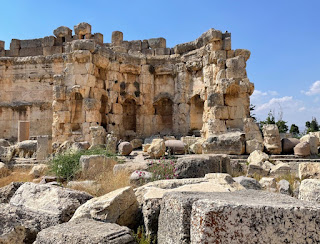Baalbek , City of the Sun
Baalbek - بعلبك
City of the SunBaalbek ( بعلبك ) is a city in Lebanon's Beqaa valley, in the city there is a large archaeological complex with ruins of ancient cities.
The Phoenicians were the first to build Baalbek and inhabit it and this was likely around 9000BC though it is not extensively documented. The city was then named Baalbek بعلبك from the two words Baal and Bak, Baal was the Pheonician and Canaanite God and Bak meant city, so it was then named 'the city of Baal".
After the Phoenicians the Greeks were in rule of the region and Alexander the Great conquered the city and renamed it in 323 BC, Ἡλιούπολις.
Ἡλιούπολις Heliopolis comes from the word Helios, which is the God of the sun in Greek mythology, making Heliopolis 'the city of the Sun".
After the death of Alexander the Great, the region fell to the Egyptian dynasty at the time, then later in 64BC was conquered by the Roman empire. Decades later Baalbek became a Roman colony, and this was the peak of its time. Baalbek was later passed to the Byzantines then finally fell under Arab domination before it officially became Lebanese.
Over time, Baalbek was destroyed and rebuilt four times; a cause of wars, earthquakes, and other natural disasters. What is now left of Baalbek are ruins of the town and an archaeological site which was even designated a UNESCO World Heritage site in 1984.
These are the famous six pillars of the colossal Roman temple, the temple of Jupiter, which is the third largest Roman colossal in the world!Because of the huge size of each pillar and their great weight, groups of Roman men and slaves had to push them horizontally so they could get them to place then push them vertically to put them in place. A small piece of those pillars is shown laying horizontally closer in the picture.
This engravement was made during Roman rule and had all the names of Jupiter "IOMH"
I: Iuppiter
OM: Optimus Maximus
H: Heliopolitanus
Baalbek was originally used as a fortress to defend the city of Baalbek and neighboring areas, and it was a very efficient one as its huge pillars and build made it great for blocking threats. The idea of Baalbek's build was to protect Roman temples and places of worship as well as the city inside.
This temple is also known as "the temple of Bacchus" the Roman god of wine, agriculture, and fertility.
It was built in the 3rd century CE and was built for the worship of Bacchus as well as enjoyment as similarly to other areas it was used for dancers, wine drinking and intoxication of other kinds.
It is said that the first three schools to exist in this area were the schools of medicine, law, and architecture. This was likely at the time of the Romans and people were taught how to engrave and create art within their temples and places of worship to beautify them.
In this part we can see engraved the symbols of wine, weed, friendship, and life, all represented.
In this specific piece of a fallen ceiling; the flower, the egg, and the arrow are engraved. The flower represents luck, status and power. The egg a symbol of life, and the arrow represented death.
There were many engravements such as this and others that represent many aspects of Roman life and beliefs.
The lion in Roman mythology represents strength, sovereignty, and justice; three values of the Roman empire.
While the bull - which was less commonly seen - represents represents courage, bravery, and strength; values of Roman men.
The Romans carved pictures and sculptures of their gods and goddesses as a way to honor them in temples and Roman cities, this was very widespread in Baalbek's temple as well until the Roman empire fell and long after the area came into the hands of the Ottomans.
When the Ottomans conquered Baalbek they got rid of almost all face and body sculptures and carvings as a victorious act as well as a religious following.
This carving is one that is still visible that shows Hercules and on the other side of the stone there previously was another carving of Apollo.
This is another carved sculpture of who is believed to be Medusa but it is unclear since it has been quite destroyed a cause of time and natural causes.
This is one of the last historical features that were added to Baalbek as it was from the Ottoman empire and has Islamic and possibly Quranic writtings in Arabic from the age of Constantine.
In Baalbek, it is also said to have had Hindu and Semitic symbols, and even writings from the time of Sam, son of Noah PBUH.
Now, it is much harder to decipher these writings as centuries have passed since then but archaeologists believe they were once there.
Baalbek is so rich in history and from many various empires and conquests, the views from the tops are also very beautiful and showed the whole area and city of Baalbek which is definitely deserving of a visit and to be enriched with its stories.







.jpeg)


Comments
Post a Comment